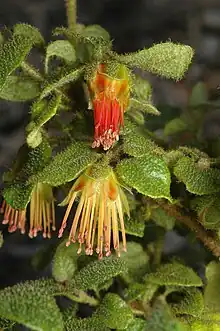Diplolaena andrewsii
Diplolaena andrewsii, is a species of flowering plant in the family Rutaceae and is endemic to the west coast of Western Australia.
| Diplolaena andrewsii | |
|---|---|
 | |
| In Kings Park, Perth | |
| Scientific classification | |
| Kingdom: | Plantae |
| Clade: | Tracheophytes |
| Clade: | Angiosperms |
| Clade: | Eudicots |
| Clade: | Rosids |
| Order: | Sapindales |
| Family: | Rutaceae |
| Genus: | Diplolaena |
| Species: | D. andrewsii |
| Binomial name | |
| Diplolaena andrewsii | |
Description
Diplolaena andrewsii is a wide spreading branched shrub to 1 m (3 ft 3 in) high. The leaves heart to egg-shaped, 1.5–4 cm (0.59–1.57 in) long, papery, sparsely covered on both sides with star-shaped, coarse, rough hairs, rounded at the apex, on a petiole 4–10 mm (0.16–0.39 in) long. The flowerheads are up to 1.5 cm (0.59 in) in diameter, outer bracts broadly oval, about 8 mm (0.31 in) long, green, rounded, papery and sparsely covered in star-shaped hairs. The inner bracts are marginally longer than outer bracts, broadly egg-shaped to narrowly oblong, reddish-brown with white edges and smooth on the outer side. The petals are more or less equal in length to inner bracts, smooth or with small hairs. The stamens 10–14 mm (0.39–0.55 in) long with light red hairs on lower half. Flowering occurs from July to September.[2]
Taxonomy
This species was first formally described in 1921 by Carl Hansen Ostenfeld and the description was published in Biologiske Meddelelser, the journal of The Royal Danish Academy of Sciences and Letters.[3][4]
Distribution and habitat
This species in found in the Darling Range near Perth, Western Australia growing in granite rocks in woodland.[2]
References
- "Diplolaena andrewsii". Australian Plant Census. Retrieved 11 August 2020.
- Wilson, Paul G. (1999). Flora of Australia-Volume 26 Meliaceae, Rutaceae, Zygophyllaceae. Canberra/Melbourne: ABRS-Department of Environment & Heritage. p. 486. ISBN 9780643109551.
- "Diplolaena andrewsii". Australian Plant Name Index. Retrieved 11 August 2020.
- Ostenfeld, Carl H. (1921). "Contributions to West Australian Botany (Part III)". Biologiske Meddelelser. 3 (2): 81. Retrieved 11 August 2020.